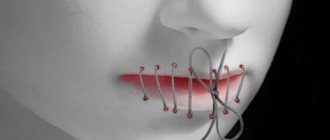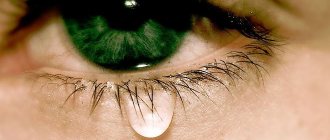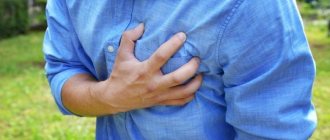Kinds
Depending on the location there are:
- Intestinal colic (small and large intestine), while appendicular and rectal colic are distinguished separately;
- Gastric colic;
- Renal colic (spasm of the ureter);
- Hepatic (biliary) colic (spasm of the gallbladder or bile duct).
There is also a distinction between functional colic (this is a consequence of external causes (diet violation, poisoning), it is temporary) and organic colic (a permanent symptom caused by pathological changes in an organ or intestinal wall).
Intestinal colic
Intestinal colic is a sharp, paroxysmal pain caused by certain changes in the intestine.
The most striking clinical signs of this disease are: 1) paroxysmal, spasmodic pain in the intestines; 2) bloating and rumbling of the intestines; 3) stool disorder (constipation or diarrhea); 4) secretion of mucus in the form of white ribbons or tubes. The allergic nature of mucous colic is confirmed by the presence of eosinophils and pointed crystals in the feces (as in sputum in bronchial asthma). Colic attacks occur after nervous shocks or conflict situations. During an attack of colic, palpation of the abdominal cavity reveals a spastically contracted large intestine, very painful. However, there is no muscle tension, the temperature remains normal. The duration of an attack of mucoid colic varies - from several minutes to a day. Outside of an attack of colic, patients remain constipated with the release of “sheep” feces.
In case of lead poisoning, lead intestinal colic develops, characterized by attacks of severe pain, the stomach is retracted, and the abdominal wall is tense. Long-term constipation is observed, there is a gray border on the gums, and other signs of lead intoxication are revealed.
The pathogenesis of intestinal colic is very complex. In some cases, pain is associated with stretching of the intestinal loops with their peritoneal covering, in others - with irritation of the nerve endings in the intestinal wall due to tension in the mesentery of the small intestines. But the main role in the mechanism of intestinal pain is played by impaired intestinal motility: tone, peristalsis, stretching and spasms of intestinal loops.
For example, with intestinal obstruction, pain is associated with increased stenotic peristalsis in the segment of the intestine located above the obstruction. In colitis and enterocolitis, they are associated with stretching and peristaltic contractions of the intestinal wall, altered due to the inflammatory process.
Intestinal colic can and should be relieved. To do this, they use medications already known to us - antispasmodics, but with some “intestinal emphasis” (i.e., predominantly acting on the intestines). Unlike biliary and renal colic, for intestinal colic (if there is no vomiting), medications are taken orally. It is possible to use the following treatment options at home: 1. 2 tablets of no-shpa, wash down with a glass of warm mint decoction; 2. dry belladonna extract (in “stomach tablets”, the preparation “becarbon”, “besalol”, “bellalgin” and “bellataminal” - 1-2 tablets, as well as in rectal suppositories); 3. papaverine tablets with platyphylline - 1-2 tablets; 4. warm therapeutic enema with a decoction of mint or lemon balm (200 ml); 5. Smecta preparation (1 powder per 100 ml of water). “Simple” intestinal colic goes away after such treatment, often after the passage of gas and a single loose stool.
The patient should not eat anything for 6-12 hours after this; You can drink warm, weak unsweetened tea with crackers.
View specialized medical institutions
www.24farm.ru
Etiology
Causes of intestinal colic:
- Digestive disorders due to diseases of the digestive tract. The spasm is caused in the small intestine when undigested food enters it;
- Improper diet - fasting, overeating, untimely meals, dry food, cold food;
- Poor nutrition – fatty, spicy, fried foods, foods that cause fermentation;
4Consumption of low-quality or stale food, which leads to poisoning;
- Intestinal infections, including parasitic ones. Waste products of parasites and toxins have an irritating effect on the intestinal wall;
- Flatulence;
- Intestinal obstruction (benign and malignant tumors, adhesions, volvulus);
- ARVI and influenza - the virus affects the lymph nodes of the intestine, which enlarge and irritate the nerve endings of the intestinal wall;
- Poisoning from chemicals such as lead;
- Stress, nervous tension. It is more pronounced in thin people;
- Increased physical activity.
Treatment of colic in adults
Patients are interested in the question of how to treat abdominal colic. Treatment for intestinal spasms depends on the specific cause. Infectious gastroenteritis usually goes away on its own within a few days. This disease requires you to take enough fluids and electrolytes. In rare cases, a bacterial infection may require antibiotics.
Invasive intervention will be needed for malignant diseases, removal of gallstones and intestinal obstruction. In most cases, appendicitis also requires surgery. Otherwise, conservative therapy is used.
If a food allergy causes intestinal spasms, you need to exclude certain foods from your diet.
Heat can relieve abdominal cramps. Sometimes your doctor will prescribe antispasmodic medications to help relieve discomfort.
Symptoms
Patients describe intense (often unbearable) cramping pain with cutting. Accompanied by weakness, sweating, and pale skin. Goes away or weakens after taking antispasmodic medications.
Depending on the cause that caused this condition, accompanying manifestations will appear, which at the initial stage of diagnosis will help determine the direction of the medical search. If there are stones in the urinary system, a pain attack will be associated with urination (often occurring after it). The pain in such a patient radiates to the lower back and groin.
An attack of hepatic colic is often triggered by a diet violation. The color of the skin becomes jaundiced, nausea and vomiting, bloating and belching with a bitter aftertaste appear.
Gastric colic is localized in the epigastric region and occurs on an empty stomach or 1.5-2 hours after eating. Accompanied by nausea. Spasms with severe anxiety are accompanied by diarrhea and a state of nervousness (shaking hands, dry mouth, rapid heartbeat).
Colic due to chemical poisoning is easily recognized by the presence of a specific black-gray border on the gums. The abdomen is greatly swollen, and a grayish complexion predominates. The area around the navel hurts.
With intestinal obstruction, there is no bowel movement and gases do not pass away, symptoms of general intoxication increase - severe weakness, lethargy.
Food poisoning is characterized by repeated vomiting, diarrhea, fever, headache, chills, and cold sweat. There are signs of general dehydration, such as dry skin, thirst, oliguria (little urine), and slow heart rate.
Flatulence is manifested by pain, bloating in the abdomen, discharge of gases, and rumbling.
Various inflammatory bowel diseases (colitis, enteritis) will be accompanied by fever, diarrhea or false urge to defecate (with rectal colic), nausea, and vomiting.
When infected with parasites, nausea, loss of appetite, and weight loss are observed.
Intestinal colic. Causes. Symptoms Treatment.
Intestinal colic is a common condition in adults and children that develops against the background of various diseases of the gastrointestinal tract. As a rule, it is associated with intestinal spasm, which provokes a severe pain attack.
The occurrence of intestinal colic requires a visit to your doctor to determine the cause and prescribe treatment if necessary.
The content of the article:
Causes of intestinal colic
Intestinal colic is not an independent disease, but a complex of symptoms associated with many potential causes. Most often, intestinal colic occurs due to pathology of the gastrointestinal tract:
- Gastritis;
- Peptic ulcer;
- Disorders of the biliary tract and gallbladder;
- Diseases of the pancreas.
These diseases are accompanied by disruption of the process of food digestion, which leads to irritation and spasms of the walls of the small intestine.
The second most common reason is an error in diet. Eating a large amount of chilled or spoiled food leads to intestinal irritation and, in some cases, to the activation of increased gas formation in it (eating large amounts of fruit, kvass and fermented milk products).
Intestinal colic can also be caused by food or drug poisoning, as well as various infectious diseases affecting the intestines (dysentery, salmonellosis, typhoid fever, etc.) pose a serious threat to human health and require immediate medical attention.
Symptoms and complaints of intestinal colic
The occurrence of intestinal colic in adults is accompanied by the formation of a typical clinical picture:
A sudden onset of severe pain, with the appearance of characteristic intestinal spasms. The pain tends to gradually increase. It can spread to the scrotum area in men, and to the genital area in women. The patient's abdominal muscles are tense, and when touched, additional pain occurs. As a rule, the pain lasts from several hours to several days, and can have a wave-like character, characterized by periodic subsidence of pain intensity and new attacks.
In addition to abdominal pain, flatulence and constipation may occur.
Important! With intestinal colic, body temperature never rises.
If intestinal colic develops in a patient with gastritis, then it is characterized by nausea and repeated vomiting.
Very often, diarrhea develops against the background of painful attacks.
In addition to the above complaints, the sick person feels general weakness and loss of appetite.
First aid for intestinal colic at home
If you or your relatives have an attack of intestinal colic, you must immediately call an ambulance. It should be remembered that in no case should you take medications on your own, as this can remove a number of symptoms necessary for a doctor to make a correct diagnosis.
However, if the attending physician finds out that this is a normal attack of intestinal colic that does not threaten a person’s health, you can do the following yourself:
- If a painful attack is associated with severe stress, then the best solution is to take some mild sedative;
- To relieve intestinal spasms, you need to take a No-shpa tablet, drotaverine or any other antispasmodic. It is recommended to additionally take the drug Smecta to relieve flatulence;
- Before taking medications, you can cleanse the intestines with an enema.
Diagnosis and treatment of intestinal colic
Intestinal colic is a manifestation of another pathology of the gastrointestinal tract, which is why they should be treated by a doctor in a specialized medical institution. It is very important to correctly compile the patient’s medical history. Of great interest is information about previous and current diseases, place of work, and contact with toxic substances. Not least important is the collection of data on diseases in the patient’s family, usual diet, and food intake before the onset of pain.
After this, an examination and palpation examination of the abdomen is performed. The appearance of pain in the abdominal muscles and their tension indicate the presence of a disease in the abdominal cavity. Additionally, you must undergo the following types of studies:
- General and biochemical blood test;
- General urine analysis;
- Examination of stool for occult blood to exclude the development of internal bleeding;
- Coprogram for assessing intestinal functions;
- Ultrasound of the abdominal organs to search for a pathological process;
- Colonoscopy for visual examination of the intestinal lumen in particularly difficult cases.
If intestinal colic occurs against the background of a disease that poses a threat to the health and life of the patient, then he must be urgently hospitalized. To relieve spastic pain, various antispasmodics (Drotaverine, Notensil) are used. It is possible to use atropine or papaverine. Analgesics are used with caution.
In addition, diet is very important.
farmmainc.com
Diagnostics
Taking an anamnesis for this condition is a very important point in diagnosis. The doctor will clarify the presence of chronic diseases of the digestive and genitourinary systems, find out the nature of nutrition, working conditions (important when in contact with chemicals). When examining, pay attention to the color of the skin, mucous membranes, and the patient’s posture.
On palpation of the abdomen, pain is usually not expressed, bloating is noted. During auscultation, increased intestinal sounds and rumbling are heard; their absence is an ominous sign and indicates intestinal obstruction.
General and biochemical blood tests are prescribed to detect inflammation (increased levels of leukocytes and ESR), helminthic infestation (increased number of eosinophils), dysfunction of the liver and pancreas.
Instrumental methods include ultrasound and radiography with a contrast agent. In more complex cases - computed tomography and magnetic resonance imaging. Endoscopic research methods are also informative - gastroduodenoscopy, colonoscopy. To study the state of the biliary system and pancreas, cholangiopancreatography and excretory urography are indicated.
Symptoms of the disease
- Sudden onset of acute pain in the stomach area. The pain syndrome is accompanied by spasm. Women feel discomfort in the labia area, and men feel discomfort in the testicle area. Usually, the pain does not go away after several hours. The discomfort in the abdominal area does not leave the patient even during the absence of spasms.
- Constipation, fecal obstruction. This symptom may not be present.
- Diarrhea. With diarrhea, light mucus is released along with the stool.
- Bloating. Flatulence is present in housing and communal services diseases such as gastritis, stomach ulcers, etc.
- There may be belching, vomiting and nausea.
- Feeling weak.
- Bad mood, apathy.
- Pale and dull skin.
- Cold sweat.
- Lack of appetite.
Intestinal spasms almost always provoke constipation. During constipation, pain occurs throughout the abdomen. In the future, stool and gas retention may occur. At the same time, the patient's blood pressure drops sharply.
It is necessary to take timely measures to eliminate all of the above symptoms, since delaying treatment can lead not only to a deterioration in the patient’s health, but also to his death.
If a person complains of acute pain in the abdomen and other symptoms of intestinal spasm, an ambulance should be called immediately. There is no need to self-medicate.
Treatment
The choice of treatment method depends on the cause of the pain. Recommendations are given on proper nutrition, reducing stress factors, changing physical activity and lifestyle.
Particular attention is paid to diet. It is necessary to exclude all harmful foods from the diet, as well as foods that promote gas formation. It is recommended to consume vegetable soups, mucous and milk porridges, fresh dairy products, homemade fruit drinks and jelly, omelettes, and casseroles. You should steam vegetables, lean meats, poultry, and fish.
To relieve an acute pain attack, antispasmodics are effective (Buscopan - selectively acts on the intestines, No-shpa, Drotaverine - systemic action).
If there is no suspicion of an inflammatory process, take a warm bath. To restore normal intestinal contractility, prokinetics (Itomed) are prescribed. In case of intestinal infection, antibiotics are prescribed. For any disturbance in the functioning of the gastrointestinal tract, it is recommended to take a course of rebamipide - it restores the mucous membrane, which allows you to get rid of pain.
Types of colic in adults
Intestinal colic can be caused by various reasons: bacterial, viral, mechanical, parasitic or medicinal. The strength and duration of colic attacks depends on the underlying disease.
Intestinal infections and toxic infections
Appendicitis can cause unbearable intestinal colic. As a rule, when the appendix is inflamed, the pain begins in the upper abdomen and gradually migrates to the lower right. A typical symptom of this disease is pain that occurs when pressure is applied to certain points in the right lower abdomen (Lanza and McBurney points).
Increased pain when releasing the palpating hand from the abdomen is considered a sign of acute appendicitis. During this test, the doctor presses on the left lower abdomen and then abruptly releases it. This causes appendicitis pain in the lower right abdomen.
Flu, acute respiratory viral infection, acute respiratory infection
One of the causes of intestinal spasm may be infectious gastroenteritis. In everyday life, gastroenteritis is called “stomach flu.” It is caused by certain bacteria (Campylobacter, Salmonella) or viruses (noroviruses, rotaviruses, other enteroviruses).
In addition to abdominal pain, diarrhea (diarrhea) and vomiting occur. Most symptoms disappear without pharmacological or other intervention after a few days. Note that the cause of intestinal spasms can be not only gastroenteritis, but also duodenitis (inflammation of the duodenum).
Helminth infection
Parasites can destroy the normal intestinal wall. Helminthiasis is a disease resulting from infection with worms. It can cause unbearable pain in the gastrointestinal tract.
Acute intestinal obstruction
Intestinal obstruction is a condition in which the normal movement of food through the digestive tract is disrupted due to mechanical or functional reasons. Mechanical causes include foreign bodies, tumors and intestinal adhesions. Functional causes include intestinal paralysis due to the action of toxic substances, drugs, or occlusion of the mesenteric arteries.
Obstruction
In both cases, intestinal obstruction can cause nausea, vomiting, changes in stool consistency, and severe abdominal pain. In case of mechanical blockade, surgical intervention is required, since the foreign body can perforate the intestinal wall.












